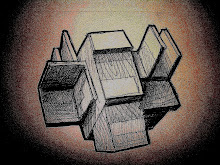Let us suppose that the idea of art can be expanded to embrace the whole range of man-made things, including all tools and writing in addition to the useless, beautiful, and poetic things of the world. By this view the universe of man-made things simply coincides with the history of art. It then becomes an urgent requirement to devise better ways of considering everything man has made.
Published in 1962, the book is written in the form of an essay, providing examples of the inter-relationship between humankind's multiple array of developed complex systems (tools, math, history, etc.) and art at length. It is pretty dense and formidable, but it breaks down very logically, an aspect I really enjoy. I am only halfway through and have gathered maybe 75% of the content, but if I understand some main points Kubler is presenting, it is these:
1. Current and past dispositions in the field of art are inherently hindered by their predisposed paths in history. The relationship between artist and movement for example, is forever linked based on our biological (his term, not mine) classification system, i.e. organizing artistic achievements and movements regionally, periodically, or based off style etc.
2. I don't think Kubler necessarily believes there is anything wrong with the practicality of this approach, he just feels that it is like examining historical achievements through a pinhole rather than the gigantic gaping hole behind it:
"... the 'history of things' is intended to reunite ideas and objects under the rubric of visual forms: the term includes both artifacts and works of art, both replicas and unique examples, both tools and expressions- in short all materials worked by human hands under the guidance of connected ideas developed in temporal sequence. From all these things a shape in time emerges... This self image reflected in things is a guide and a point of reference to the group (of people) for the future, and it eventually becomes the portrait given to posterity."
So far, the merit of this book is unprecedented. It is really a fantastic way to approaching history on general terms, de-emphasizing the significance of art while retaining its absoluteness as a legitimate human necessity. I am totally excited to read the rest, even if it does take a while to do so.
That said, I was very lazily sitting around the other day gorging on cookies when a show called Inside Air Force One came on the National Geographic Channel. It was pretty absurd learning about the security measures and amenities provided by the president's plane. Did you know there are two Air Force Ones? And they're not officially recognized as Air Force One until the president is on board? At one point during the show, there was a scene in which Air Force One landed in Israel, and taxied right up to the already rolled out red carpet. The pilot could be heard talking about representing America and just how important and perfect every aspect of a landing had to be over imagery (from his window) of military guards holding flags and saluting the president as he strolled off the steps and into the diplomatic foray of Israeli leaders. It was this instance I found most intriguing. The perspective given from the cockpit gave off a very weird energy, depicting a somewhat abstract essence of what being a person of world stature would be like firsthand. The cockpit view captured a subtle yet interesting actuality I just can't imagine being shared by that many people throughout the world, diminishing the grandeur of the event to a level of purely engaged reality. The elevation of such an event has to be the means of ensuring its historical significance. However, it's interesting that such significance is beheld by only a handful of people whom actually experience it as legitimate reality. This is not to say it is overemphasized, or even that it is unnecessary (OR even that my experience of it through recorded and edited film did not elicit some of its own significance), but rather that it is nearly entirely focused within a specific core of people, while the rest of the world has to experience it through miles upon miles of wires. Watching the footage of that scene took me on a thought path that totally subtracted all media filters and lead to some of these conclusions. On some levels, it was kind of like looking at a fine Baroque painting in person, seeing it in its rawest and purest form, and focusing on how the frame took more time to make than the actual image inside it. Regardless, I can't imagine what kind of pressure something like exiting Air Force One into a foreign country would demand, let alone what it would be like to be greeted on such a massive scale. Everything on the president's schedule is apparently timed down to the minute and there is no room for error or setbacks. That means no sleeping in or sitting around to watch National Geographic when your job gets a little hectic. What is it like to have an entire country depending on you? I think its hard enough living up to Facebook standards let alone those of 304,059,724 people. Well whatever, I used to want to be the president, but I don't really anymore.

No comments:
Post a Comment